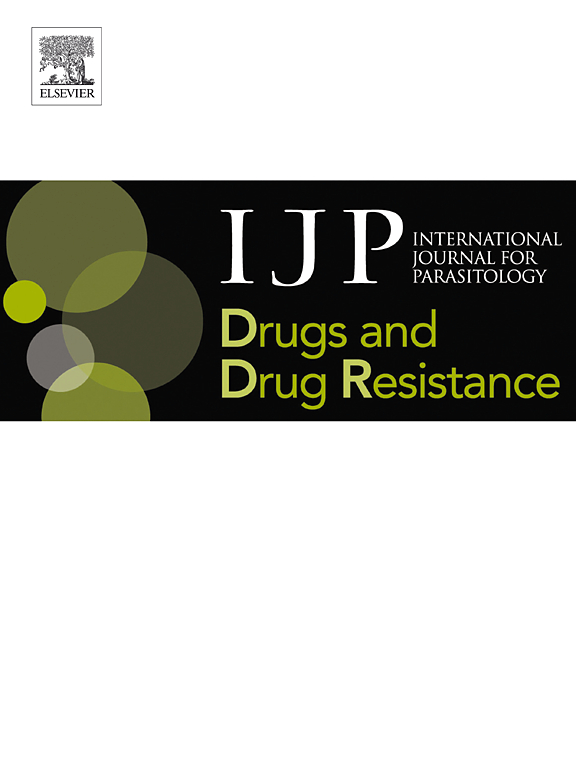Transcriptional responses to in vitro macrocyclic lactone exposure in Toxocara canis larvae using RNA-seq
IF 3.4
2区 医学
Q1 PARASITOLOGY
International Journal for Parasitology: Drugs and Drug Resistance
Pub Date : 2025-09-19
DOI:10.1016/j.ijpddr.2025.100614
引用次数: 0
Abstract
Toxocara canis, the causative agent of zoonotic toxocariasis in humans, is a parasitic roundworm of canids with a complex life cycle. While macrocyclic lactones (MLs) are successful at treating adult T. canis infections when used at FDA-approved doses in dogs, they fail to kill somatic third-stage larvae. In this study, we profiled the transcriptome of third-stage larvae derived from larvated eggs and treated in vitro with 10 μM of the MLs ivermectin and moxidectin. We analyzed transcriptional changes in comparison with untreated control larvae. In ivermectin-treated larvae, we identified 608 differentially expressed genes (DEGs), of which 453 were upregulated and 155 were downregulated. In moxidectin-treated larvae, we identified 1413 DEGs, of which 902 were upregulated and 511 were downregulated. Notably, many DEGs were involved in critical biological processes and pathways including transcriptional regulation, energy metabolism, body structure and function, physiological processes such as reproduction, excretory/secretory molecule production, host-parasite response mechanisms, and parasite elimination. We also assessed the expression of known ML targets and transporters, including glutamate-gated chloride channels (GluCls), and ATP-binding cassette (ABC) transporters, subfamily B, with a particular focus on P-glycoproteins (P-gps). We present gene names for previously uncharacterized T. canis GluCl and transporter genes using phylogenetic analysis of nematode orthologs to provide uniform gene nomenclature. Our study revealed that the expression of two GluCls and eight ABCB genes, particularly five P-gps were significantly altered in response to ML treatment. Compared to controls, Tca-glc-3, Tca-avr-14, Tca-haf-10, and Tca-Pgp-13.2 were downregulated in ivermectin-treated larvae, while Tca-abcb7, Tca-Pgp-11.2, and Tca-Pgp-2 were downregulated in moxidectin-treated larvae. Conversely, Tca-haf-9, Tca-Pgp-11.3, and Tca-Pgp-16.3 were upregulated in moxidectin-treated larvae. These findings suggest that MLs broadly impact transcriptional regulation in T. canis larvae.

利用RNA-seq技术研究犬弓形虫幼虫对体外大环内酯暴露的转录反应
犬弓形虫是一种具有复杂生命周期的犬类寄生蛔虫,是人类人畜共患弓形虫病的病原体。当大环内酯(MLs)以fda批准的剂量用于狗时,可以成功治疗成年犬T.犬感染,但它们不能杀死第三阶段的体细胞幼虫。在这项研究中,我们用10 μM的MLs伊维菌素和莫西菌素体外处理了从幼虫卵中提取的第三期幼虫的转录组。我们分析了与未经处理的对照幼虫的转录变化。在伊维菌素处理的幼虫中,我们鉴定出608个差异表达基因(deg),其中453个表达上调,155个表达下调。在莫西菌素处理的幼虫中,我们鉴定出1413个deg,其中902个上调,511个下调。值得注意的是,许多deg参与了关键的生物学过程和途径,包括转录调节、能量代谢、身体结构和功能、生殖、排泄/分泌分子产生、宿主-寄生虫反应机制和寄生虫消除等生理过程。我们还评估了已知ML靶点和转运体的表达,包括谷氨酸门控氯通道(GluCls)和atp结合盒(ABC)转运体,亚家族B,特别关注p糖蛋白(P-gps)。我们使用线虫同源物的系统发育分析来提供统一的基因命名,为以前未被表征的犬绦虫葡萄糖和转运基因命名。我们的研究表明,两种葡萄糖和8种ABCB基因的表达,特别是5种P-gps在ML治疗后显著改变。与对照组相比,伊维菌素处理的幼虫中Tca-glc-3、Tca-avr-14、Tca-haf-10和Tca-Pgp-13.2下调,而莫西菌素处理的幼虫中Tca-abcb7、Tca-Pgp-11.2和Tca-Pgp-2下调。相反,tca -半-9、Tca-Pgp-11.3和Tca-Pgp-16.3在莫西菌素处理的幼虫中表达上调。这些发现表明MLs广泛影响犬绦虫幼虫的转录调控。
本文章由计算机程序翻译,如有差异,请以英文原文为准。
求助全文
约1分钟内获得全文
求助全文
来源期刊

International Journal for Parasitology: Drugs and Drug Resistance
PARASITOLOGY-PHARMACOLOGY & PHARMACY
CiteScore
7.90
自引率
7.50%
发文量
31
审稿时长
48 days
期刊介绍:
The International Journal for Parasitology – Drugs and Drug Resistance is one of a series of specialist, open access journals launched by the International Journal for Parasitology. It publishes the results of original research in the area of anti-parasite drug identification, development and evaluation, and parasite drug resistance. The journal also covers research into natural products as anti-parasitic agents, and bioactive parasite products. Studies can be aimed at unicellular or multicellular parasites of human or veterinary importance.
 求助内容:
求助内容: 应助结果提醒方式:
应助结果提醒方式:


